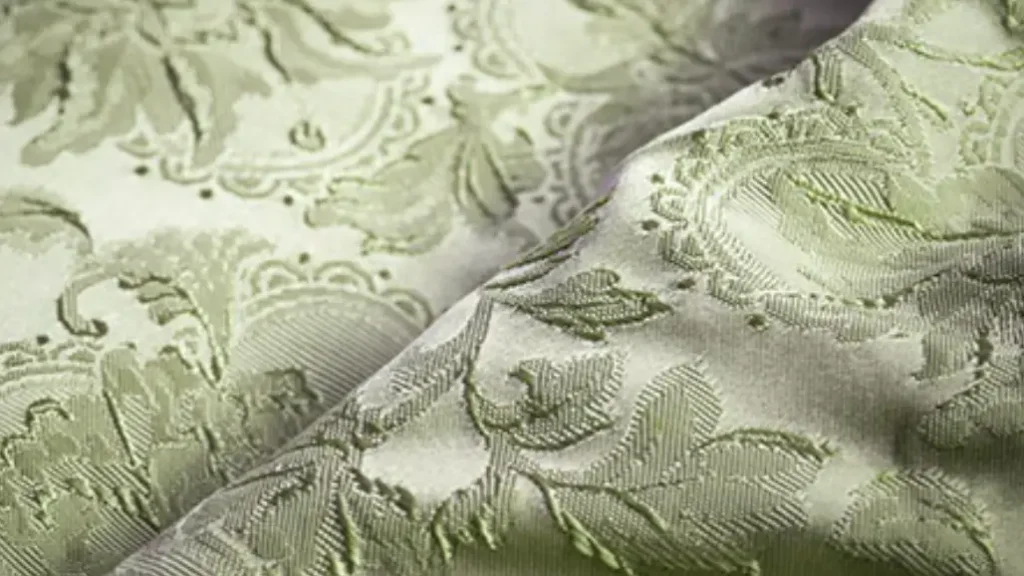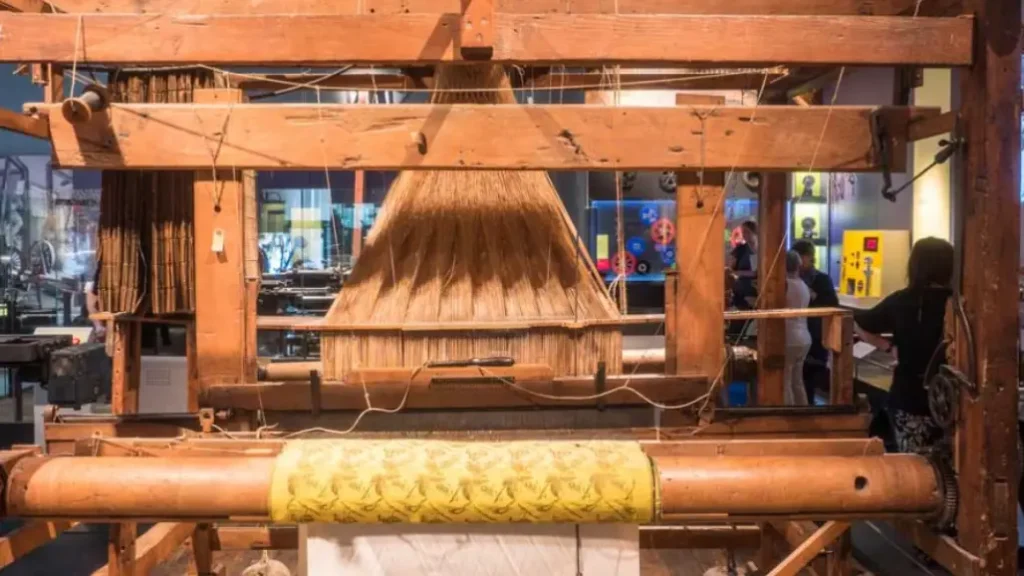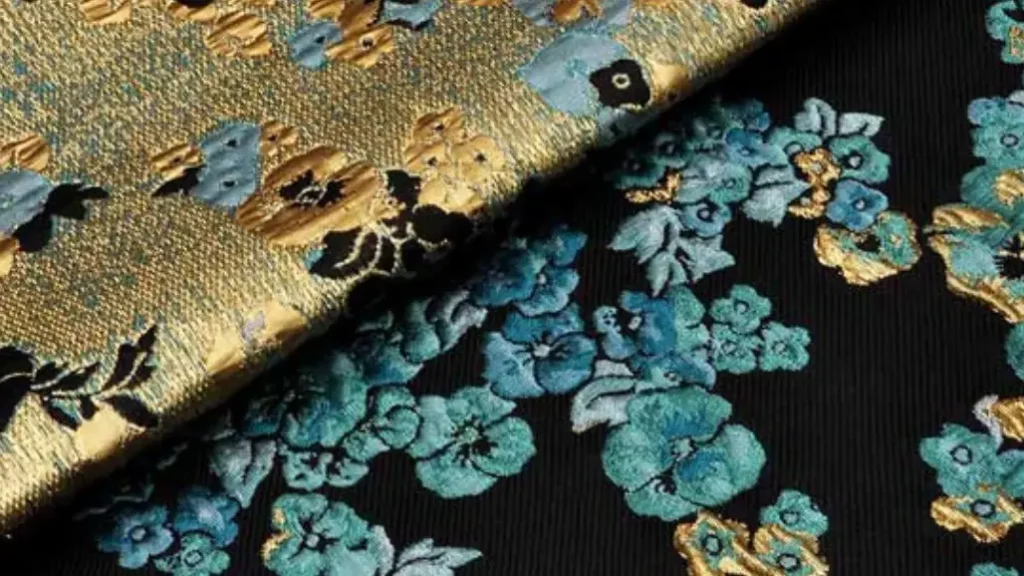Have you ever been mesmerized by a garment or furnishing boasting intricate, woven patterns? Chances are, you’ve encountered the luxurious world of jacquard fabric. Renowned for its detailed designs and rich history, jacquard elevates ordinary textiles into works of art.
In this blog post, we’ll delve into the captivating world of jacquard, exploring its unique creation process, its benefits, and the countless ways it can be incorporated into your life.
What Is Jacquard Fabric?

Jacquard fabric isn’t just any patterned textile; it’s a category defined by its unique weaving method.
Jacquard Fabric Definition
Jacquard fabric is a type of cloth that features intricate patterns woven directly into its structure. These patterns are created using a special loom called a Jacquard loom, which employs a system of punched cards or computer-controlled mechanisms to precisely control the weaving process. This allows for the creation of highly detailed and complex designs that would be impossible to achieve with traditional weaving methods.
The name “jacquard” comes from Joseph Marie Jacquard, a French inventor who, in 1804, developed a revolutionary loom that automated the complex weaving process required to create these intricate patterns. This invention revolutionized textile production, allowing for the creation of highly detailed and ornate fabrics that were previously impossible to produce on a large scale.
- Woven, Not Printed: Unlike printed fabrics where patterns are applied on top, jacquard features intricate designs woven directly into the fabric itself. This creates a richer, more textured appearance with superior durability.
- Made on a Jacquard Loom: The key to jacquard’s magic lies in the Jacquard loom, a complex machine invented in 1804. This loom uses punched cards to control individual threads, allowing for incredibly detailed and intricate patterns.
- Wide Range of Designs: Jacquard fabrics can boast a vast array of designs, from classic damasks and florals to modern geometric patterns and even photographic imagery. The possibilities are virtually endless.
- Natural or Synthetic Fibers: While traditionally made with luxurious fibers like silk and wool, jacquard fabrics today can be crafted from natural or synthetic fibers, offering a range of price points and functionalities.
Jacquard Fabric Characteristics
Jacquard fabric is a type of cloth characterized by intricate patterns woven directly into the fabric itself, rather than being printed or embroidered on top.
Here are some key characteristics of Jacquard fabric:
- Intricate Patterns: The defining feature of Jacquard fabric is its complex and often elaborate patterns. These can range from simple geometric shapes to highly detailed floral motifs, landscapes, or even portraits.
- Weaving Technique: The patterns are created during the weaving process using a special type of loom called a Jacquard loom. This innovative loom, invented by Joseph Marie Jacquard in the 19th century, uses a system of punched cards to control the weaving process, allowing for intricate and complex designs.
- Versatility: Jacquard fabrics can be made from a variety of fibers, including cotton, silk, wool, linen, and synthetic materials. They come in a wide range of weights, textures, and colors, making them suitable for a variety of applications.
- Durability: Due to the tight weave and strong interlacing of yarns, Jacquard fabrics are generally quite durable and resistant to wear and tear.
- Aesthetic Appeal: The intricate patterns and luxurious feel of many Jacquard fabrics make them a popular choice for high-end applications.
What Does Jacquard Fabric Feel Like?
Jacquard fabric can feel quite different depending on the fibers used, the weave pattern, and the intended use. Generally, it has a rich and textured feel due to the raised and recessed areas created by the intricate weave.
Silk jacquard often feels incredibly soft and luxurious against the skin, while cotton jacquard tends to be more crisp and breathable. Wool jacquard provides a warm and cozy feel, while linen jacquard offers a unique, slightly rough texture. Synthetic jacquard fabrics can vary greatly in feel, from smooth and silky to slightly stiff and crisp.
What is Jacquard Fabric Made Of?
Jacquard fabric can be made from a wide variety of fibers, both natural and synthetic.
Synthetic fibers such as polyester, nylon, and rayon are also commonly used in jacquard weaving. These synthetic options can offer increased durability, wrinkle resistance, and affordability compared to some natural fibers. Blends of natural and synthetic fibers are also often used to create jacquard fabrics with enhanced performance and a balance of desirable qualities.
Jacquard Fabric Material
Common natural fibers used to create jacquard include, and here are some widely used Jacquard Fabric Materials
- Silk: Known for its luxurious sheen and drape, silk jacquard is prized for its elegance and often used in high-end fashion and home decor.
- Cotton: A more affordable option, cotton jacquard offers a comfortable and breathable fabric with good durability.
- Wool: Often used for heavier jacquard fabrics, wool provides warmth and insulation, making it suitable for winter clothing and home furnishings.
- Linen: Linen jacquard offers a unique texture and a crisp, cool feel, making it popular for summer clothing and home decor.
How is Jacquard Fabric Made?

Jacquard fabric’s intricate designs come to life through a fascinating process that combines human ingenuity and mechanical marvel. Here’s a breakdown of how jacquard fabric is made:
- Design Creation: The journey begins with the design itself. Jacquard designs can be anything from classic florals to modern geometrics, even replicating photographic imagery.
- Programming the Loom: This design is then translated into a series of instructions for the Jacquard loom. Traditionally, punched cards were used, with each hole corresponding to a specific warp thread being raised during weaving. Today, computerized systems have replaced these cards, allowing for even greater design complexity.
- The Jacquard Loom: The heart of the process is the Jacquard loom, invented in the early 1800s by Joseph Marie Jacquard. This loom operates with two sets of threads: warp threads (lengthwise) and weft threads (crosswise). The Jacquard mechanism controls each warp thread individually.
- Lifting the Warps: During weaving, the Jacquard mechanism raises and lowers specific warp threads based on the design instructions. This selective lifting creates “sheds” through which the weft thread is passed.
- Building the Pattern: As the weaving progresses, the raised and lowered warp threads interact with the weft thread, building the intricate design layer by layer into the fabric itself.
- The Finished Product: The final result is a stunning piece of jacquard fabric where the design is not just an afterthought, but an integral part of the woven structure. This weaving technique creates a fabric rich in detail, texture, and unmatched durability.
What is Jacquard Loom?
The Jacquard loom, invented in the early 1800s by Joseph Marie Jacquard, is a revolutionary weaving machine that allows for the creation of incredibly intricate and detailed patterns directly into fabric. It’s a key component in what makes jacquard fabric so unique. Here’s a breakdown of its significance:
- Individual Thread Control: Unlike traditional looms, the Jacquard loom boasts the ability to control each warp thread (the threads running lengthwise in the fabric) individually. This level of precision is what allows for complex designs with numerous details.
- Punched Cards (Traditionally): Originally, the Jacquard loom used a system of punched cards to program the weaving pattern. Each hole in a card corresponded to a specific warp thread being raised during weaving. A sequence of these cards, linked together, would then dictate the entire design.
- Modernized Systems: Today, punched cards have been replaced by computerized systems. These electronic systems offer even greater flexibility and control, allowing for even more intricate and detailed designs to be woven.
- Impact on Jacquard Fabric: The Jacquard loom’s ability to control individual threads is what enables the creation of intricate woven patterns that become an integral part of the fabric. This sets jacquard apart from printed fabrics where designs are applied on top, resulting in a richer, more textured, and durable final product.
Uses of Jacquard Fabric
Jacquard fabric, with its intricate woven designs and luxurious feel, finds applications across various domains. Here’s a look at some of the most common uses of jacquard fabric:
Fashion:
- Clothing: Jacquard fabrics are a favorite for creating elegant and statement pieces in clothing. From luxurious dresses and gowns to sophisticated jackets and skirts, the fabric adds a touch of sophistication and texture to any outfit.
- Ties and Scarves: Jacquard’s intricate patterns are perfect for creating stylish ties and scarves that elevate even the simplest attire.
Home Decor:
- Upholstery: Jacquard fabrics are a popular choice for upholstering furniture like sofas, armchairs, and ottomans. The rich textures and patterns add a touch of luxury and visual interest to any living space.
- Drapery and Curtains: Jacquard drapes and curtains can make a dramatic statement in a room. The intricate woven designs can add depth, color, and elegance to windows and doorways.
- Bedding: Jacquard bedspreads and comforters can add a touch of luxury and visual interest to a bedroom. The fabric’s rich textures and patterns can create a warm and inviting atmosphere.
Other Uses:
- Table Linens: Jacquard tablecloths and napkins can elevate a dining experience. The intricate designs add a touch of sophistication and formality to any table setting.
- Bags and Accessories: Jacquard fabrics are used to create stylish and unique bags, clutches, and wallets. The woven patterns add a touch of personality and flair to these everyday accessories.
- Wall Hangings and Tapestry: Jacquard fabrics can be used to create stunning wall hangings and tapestries. The intricate designs can serve as beautiful focal points in a room.
Beyond the aesthetics, jacquard fabric offers several practical benefits:
- Durability: The woven nature of the patterns makes jacquard fabrics highly durable compared to printed fabrics. The designs become an integral part of the fabric, reducing the risk of fading or peeling.
- Versatility: Jacquard fabrics can be found in a wide range of designs, from classic damasks to modern geometrics. This versatility allows for a wide array of applications.
So, whether you’re looking to add a touch of luxury to your clothing, elevate your home decor, or create a unique accessory, jacquard fabric offers a wealth of possibilities.
Types of Jacquard Fabric

While all jacquard fabrics share the same basic weaving method using a Jacquard loom, the resulting fabric can vary depending on the fiber content, design aesthetic, and intended use. Here’s a glimpse into some of the most common types of jacquard fabrics:
By Fiber Content:
- Silk Jacquard: Known for its luxurious feel and beautiful drape, silk jacquard is often used for high-end clothing, evening wear, and formal drapes.
- Cotton Jacquard: Offering a balance of affordability and durability, cotton jacquard is a popular choice for home decor items like upholstery, curtains, and table linens.
- Wool Jacquard: Known for its warmth and texture, wool jacquard is often used for upholstery, throws, and blankets.
- Synthetic Jacquard: Made from polyester or nylon blends, synthetic jacquards offer affordability, durability, and stain resistance, making them suitable for everyday items like bags and lighter upholstery.
By Design Aesthetic:
- Damask: Damask jacquards feature intricate, floral or geometric designs often woven onto a contrasting background color. They exude a timeless elegance and are popular for upholstery, drapery, and table linens.
- Brocade: Brocade jacquards boast raised patterns woven with metallic threads or yarns of different colors, creating a rich and luxurious look. They are often used for formal clothing, upholstery, and wall hangings.
- Matelassé: Matelassé jacquards feature a raised, quilted effect created by weaving additional weft threads. This technique adds depth and texture to the fabric, making it popular for bedspreads, throws, and clothing with a vintage feel.
By Use:
- Jacquard Upholstery Fabric: Typically made from durable fibers like cotton or synthetic blends, these jacquards come in various patterns and colors suitable for sofas, chairs, ottomans, and headboards.
- Jacquard Apparel Fabric: Made from silk, cotton, or synthetic blends, these jacquards feature lighter weights and intricate designs for creating dresses, jackets, skirts, and statement pieces.
- Jacquard Home Decor Fabric: Often made from cotton or synthetic blends, these jacquards offer a wide range of designs for curtains, blinds, tablecloths, napkins, and throw pillows.
Remember, this is not an exhaustive list, and jacquards can be further categorized based on specific weaving techniques or regional design influences.
Jacquard Fabric Care Instructions
Check the Care Label: Always refer to the care label on your specific jacquard item for the most accurate instructions.
Gentle Cleaning:
- Hand Wash: For delicate fabrics (like silk), hand wash in cool water with a mild detergent.
- Machine Wash: If machine washing is permitted, use a gentle cycle with cold water.
- Avoid Harsh Chemicals: Do not use bleach or fabric softeners, as they can damage the fibers and colors.
- Air Dry: Air dry the fabric flat or on a hanger to prevent shrinkage and distortion. Avoid direct sunlight.
- Ironing: If ironing is necessary, use a low temperature and place a thin cloth between the iron and the fabric.
- Professional Dry Cleaning: For heavily soiled or delicate items, professional dry cleaning is often recommended.
Important Notes:
- Regular Dusting: Regularly dust or vacuum your jacquard fabric items to prevent dirt buildup.
- Spot Clean Quickly: If spills occur, blot them immediately with a clean cloth to prevent stains from setting.
- Avoid Abrasion: Be gentle when handling jacquard fabric, as excessive rubbing can damage the intricate weave.
By following these care instructions, you can help maintain the beauty and longevity of your jacquard fabrics.
Conclusion
Jacquard fabric is a testament to the artistry and innovation of textile weaving. Its intricate patterns and luxurious feel elevate any design, from high-fashion garments to elegant home decor. Whether you’re drawn to the timeless elegance of silk jacquard or the modern appeal of synthetic blends, the unique characteristics of this fabric make it a captivating choice for designers and discerning consumers alike.
Ready to explore the possibilities of jacquard fabric for your next project? Fanda Fabrics offers a wide selection of high-quality jacquard fabrics in a variety of colors, patterns, and compositions, all available at wholesale prices.
Contact us today to learn more about our extensive inventory and discuss your specific needs. Our team of experts is dedicated to providing exceptional customer service and helping you find the perfect jacquard fabric to bring your creative vision to life.
